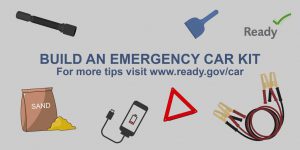Winter isn’t just around the corner—it’s hear today! Make sure your vehicle and emergency vehicle kit are ready to keep you safe and prepared.
Prepare Your Vehicle
- Install good winter tires. Make sure each tire has enough tread.
- Keep your gas tank full. A full tank keeps the fuel line from freezing, and it’s also a good idea in case you lose power.
- Batteries lose power as temperatures drop, so be sure to have yours tested.
- Have your vehicle’s antifreeze level and radiator system checked.
- Proactively replace your car’s worn wiper blades.
- To help with visibility, clean off your car entirely—including your trunk, roof, windows, and headlights.
Prepare Yourself
Making sure your emergency vehicle kit is fully stocked:
- Water, non-perishable food, and an extra set of warm clothes in case you get stranded
- Jumper cables
- Cat litter or sand for better tire traction
- Car cell phone charger
- Ice scraper
- Flares or reflective triangle
For more information about winter vehicle safety, visit: www.ready.gov/car.

